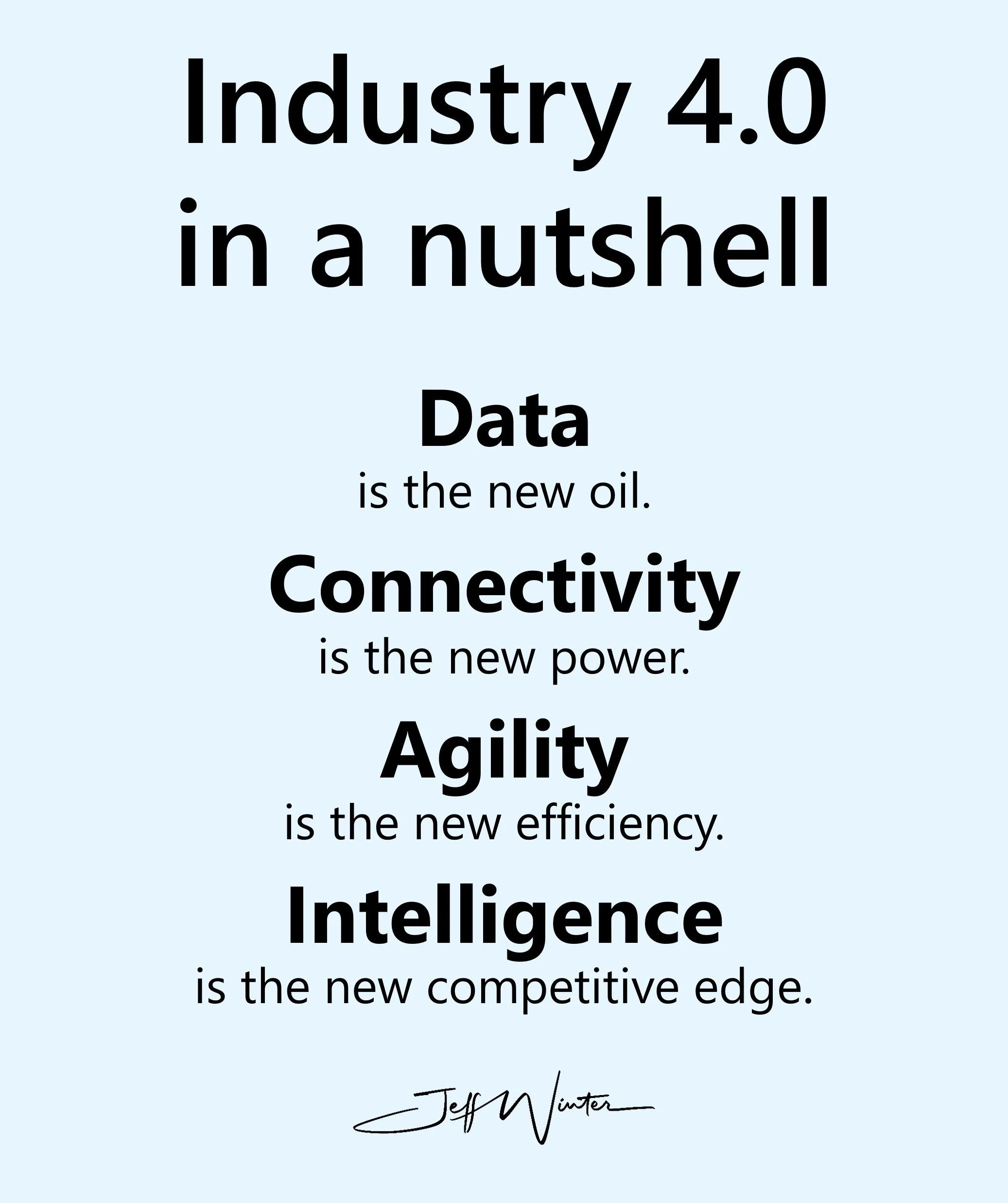Industry 4.0 in a Nutshell: The Race You Didn’t Know You Were In
Industry 4.0 is a race. The problem? Not everyone knows they’re in it yet.
The question isn’t if you’ll adapt.
It’s how fast you’ll adapt.
And in this race, the speed isn’t just about technology—it’s about how well you harness four new foundations of advantage: Data, Connectivity, Agility, and Intelligence.
Data is the New Oil
We’ve all heard the phrase, but let’s make something clear: oil is scarce. Data isn’t.
Oil is burned once and gone. Data doesn’t deplete, it multiplies. It is perpetually replenished every second by sensors, machines, transactions, and people.
And unlike oil, data can be shared without being diminished. If I hand you a barrel of oil, I lose it. If I share a dataset, I still have it, and now we both gain, because combining and cross-referencing data often creates more value than either dataset alone.
That’s why data is the raw material of Industry 4.0. The challenge isn’t in finding it. It’s in refining it, cleaning, curating, and converting it into insights that drive smarter decisions and faster innovation.
The winners of this race won’t simply be those who have the most data. It will be those who refine and share it best.
Connectivity is the New Power
Power used to mean size, scale, and standing on your own. In the digital age, real power comes from being plugged in.
Factories, suppliers, machines, and customers all form part of a larger network. The more connected you are, the more resilient and capable you become. A single plant operating in isolation is like a smartphone with no signal: technically functional, but irrelevant.
Connectivity multiplies strength. It allows supply chains to see disruptions before they happen, customers to give real-time feedback, and partners to co-innovate.
In the old world, hoarding knowledge and protecting silos seemed safe. In Industry 4.0, isolation is weakness. Power flows from networks, ecosystems, and shared platforms.
The more plugs in the socket, the brighter the light.
Agility is the New Efficiency
Efficiency once meant squeezing costs, running lean, and optimizing down to the decimal. But efficiency in Industry 4.0 isn’t about cutting deeper—it’s about moving faster.
Today, markets shift overnight. Supply chains fracture with a single shock. Customer demands flip in months, not years. In that environment, efficiency is redefined as agility, the ability to adapt quickly without breaking stride.
Consider two manufacturers. One saves a dollar per unit but takes six months to adjust operations. The other saves nothing per unit but can reconfigure in a week. Which one thrives when disruption hits?
The agile one. Every time.
In this race, efficiency isn’t measured by cost per unit anymore—it’s measured by time to adapt.
Intelligence is the New Competitive Edge
For generations, leaders relied on gut instinct. That worked in simpler times. But when products have thousands of parts, supply chains span continents, and customer expectations shift weekly, instinct alone isn’t enough.
Intelligence, human and artificial, is the new edge.
AI can forecast demand, optimize production, and predict failures. But people still bring the judgment, creativity, and context. The real competitive advantage comes when the two work together: human insight amplified by machine precision.
And while anyone can buy an algorithm, few can build a culture that embeds intelligence at every level. The winners are the companies where insights flow from the top floor to the shop floor, where every decision is informed by real-time clarity, and where intelligence compounds like interest over time.
That’s what makes intelligence the hardest edge to copy.
Where to Begin
The hardest part of Industry 4.0 is not understanding what matters, it is knowing where to start. Companies see endless possibilities (data platforms, IoT connectivity, AI pilots, agile operations, digital twins, etc.) and quickly feel overwhelmed. The risk is that the enormity of the challenge creates paralysis. Leaders spend so much time analyzing options that competitors sprint ahead.
The truth is you do not need to get everything right on the first try. What matters most is creating momentum. Industry 4.0 is not about chasing shiny tools one by one. It is about building an integrated system where data, connectivity, agility, and intelligence reinforce one another. That means the best starting point is not a specific technology but a mindset that develops these elements together.
Here is how to think about it:
First step is movement. Do something visible that creates momentum. Map where your data already exists and make it useful. Connect one part of your supply chain to another. Run a small pilot that demonstrates how information and insight can flow faster. The point is not perfection, it is progress. Movement builds belief across the organization that Industry 4.0 is not just a concept but a reality.
Second step is integration. Once you start moving, the real value comes from connecting the pieces. Treat data, connectivity, agility, and intelligence as interdependent rather than separate projects. Data without connection stays siloed. Connectivity without agility creates fragility. Intelligence without clean inputs amplifies noise. Integration ensures these building blocks reinforce one another and multiply value rather than stall out on their own.
Third step is scale. After proving the model in pockets, expand it across the enterprise. Tackle pain points that span departments such as downtime, inventory shortages, or recurring quality issues. These challenges force you to use all four levers together and make wins visible quickly. Scaling is where Industry 4.0 shifts from scattered pilots to a system-level upgrade of how the business operates.
The companies that succeed do not treat Industry 4.0 as a list of disconnected projects. They treat it as a journey of integration. Start moving, connect the dots, then scale what works. Those who embrace this approach will not only keep pace in the race, they will take the lead.

